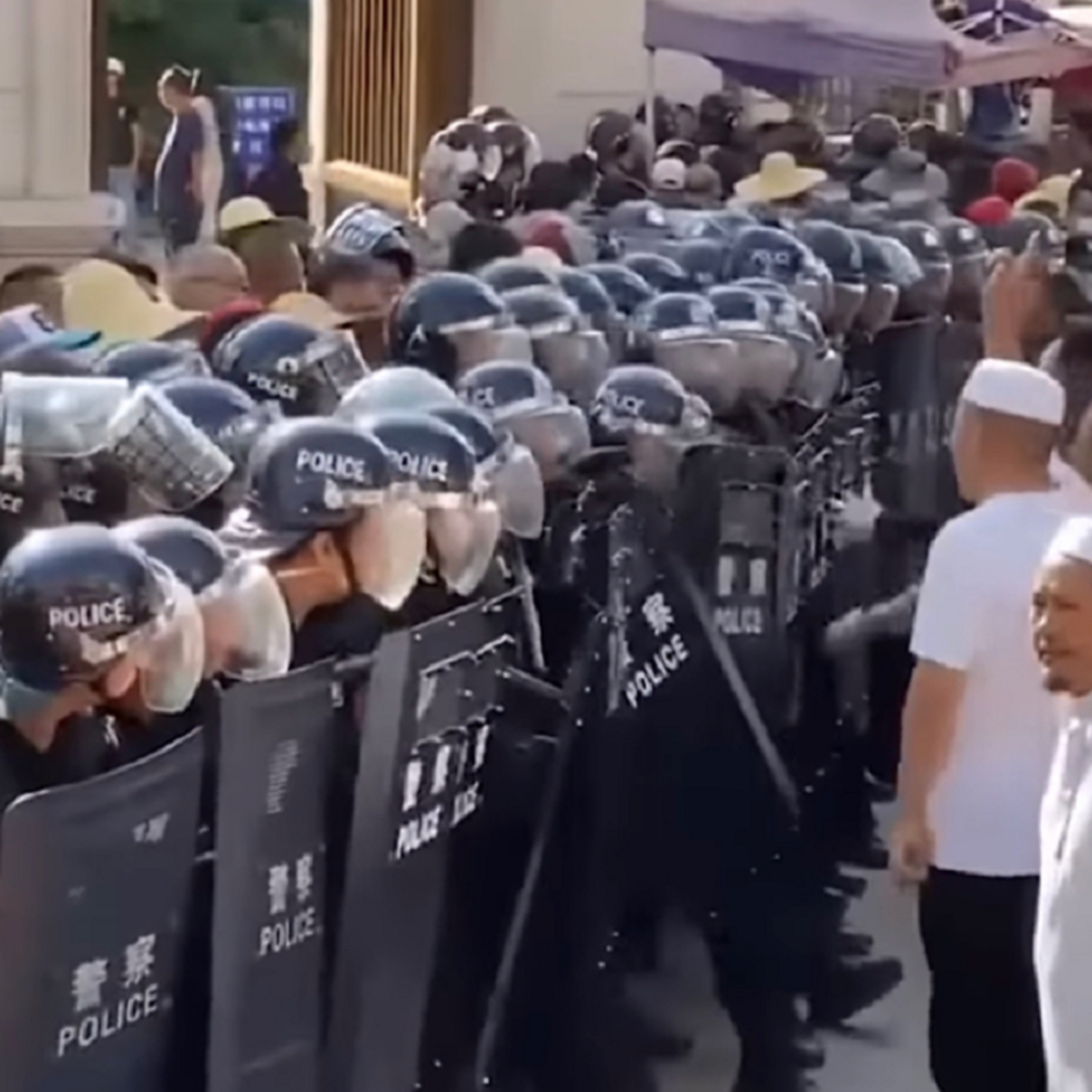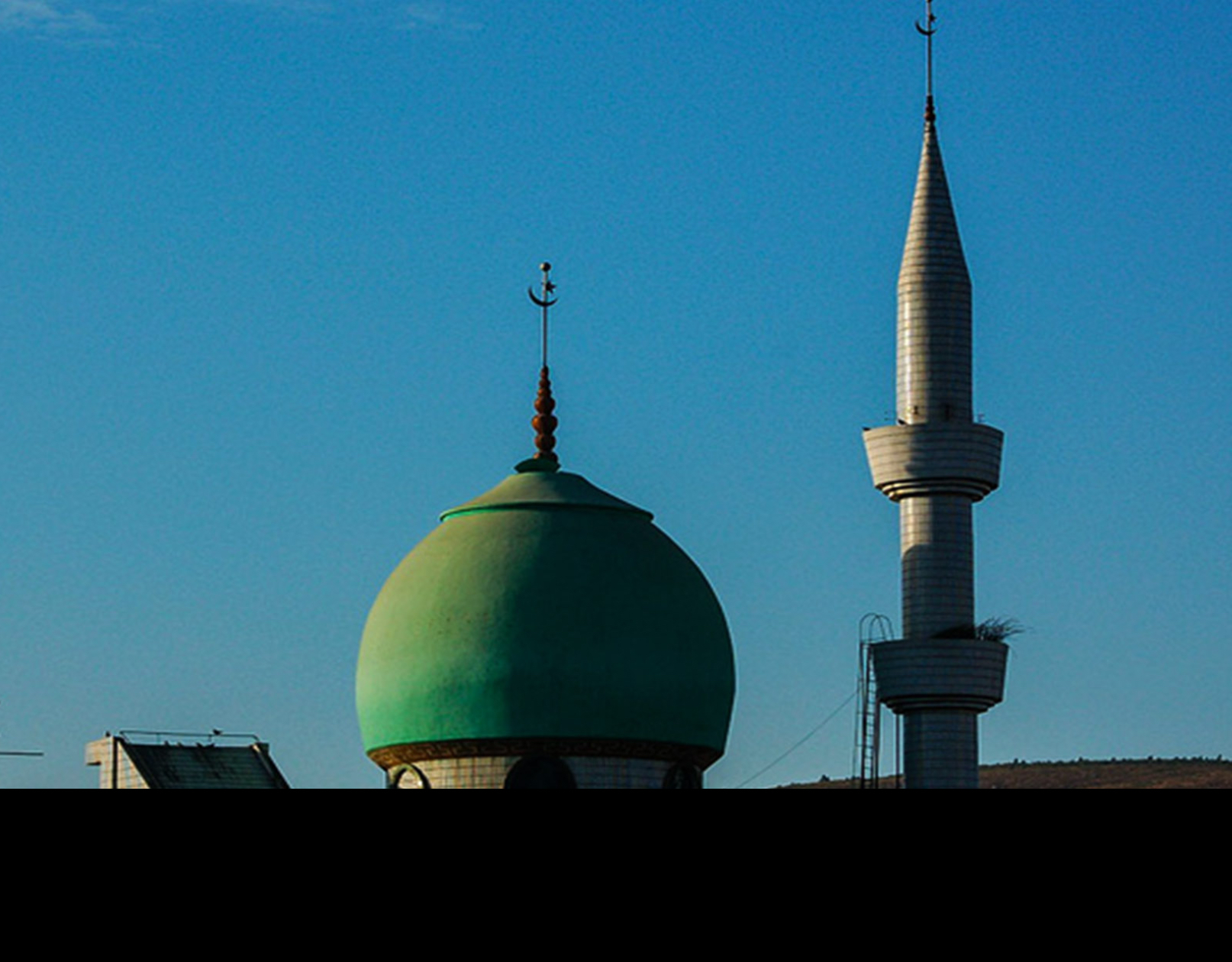Whilst our sights have been on the Uighurs in Xinjiang over the last few years, the Chinese authorities have been systematically shutting down thousands of Mosques and/or removing overtly Islamic architecture from thousands more in other Muslim communities, which includes destroying domes and tearing down minarets.
This weekend 28th~29th May, thousands of Hui Muslims in Najiaying village, in the Yunnan province of Southwestern China, were compelled to assemble en masse, to encircle their 13th Century Mosque, in order to prevent the authorities from demolishing the large green dome at its centre and the four surrounding minarets. Hui activists have said that the Najiaying mosque ‘is one of the last holdouts’. Videos which have been posted on social media, show local residents facing-off over a thousand police officers in riot gear, who attempted to block off the entrance to the mosque and to push back the crowd with shields and batons. The footage reveals angry protesters throwing water-filled bottles and bricks at the police. One of the protesters is recorded saying:
‘This is our last bit of dignity… It’s like coming to our house to demolish our home. We can’t allow that to happen.’
Another local resident, having arrived and witnessed the scaffolding around the mosque declared to news reporters:
‘After arriving at the mosque, we realised that they had driven the cranes into the compound and were ready for the forced demolition’
Locals take a stand against over a thousand police
A stand-off then followed, with groups of protesters taking it in turns to stand guard throughout the weekend. Although there were attempts to intimidate the protesters – truncheons were regularly banged on the ground and there were dozens of arrests, the protesters refused to be moved and eventually, for the time being at least, the police were forced to retreat.

A short-term victory, but locals now wait in fear for what happens next
In the days following, public announcements were broadcast on tannoy systems urging those who took part in the action and who had ‘seriously disrupted public order’, to hand themselves in to the authorities before June 6th in order to receive leniency and that they should provide details of others who had participated to prove their loyalty to the state. The Internet facility across the neighbourhood had been suddenly cut off and according to one news report ‘drones buzzed overhead and surveilled the village’. High levels of anxiety continue to prevail as locals wait unknowing as to what may happen next. The locals are now waiting in fear, commentators have said.
Most residents will likely be familiar with a similar stand-off which took place in another province of Ningxia back in 2018, when the Hui Muslim locals staged a sit-in over a three day period to prevent the demolition of a newly built mosque. Plans for the demolition were eventually dropped, but the minarets and the dome of the mosque were eventually removed and replaced with traditional styled Chinese pagodas.
The crackdown
The crackdown, which has been visited on Muslims throughout China over several years since the rioting in Urumqi in 2009, in recent years hit the headlines of the Western press with the shocking revelations of extreme programmes of persecution against the Uighur Muslims within the Xinjiang province in North Western China. Details of the incarceration of an estimated one million Muslim Uighurs in indoctrination camps (or as the Chinese authorities refer to them ‘re-education centres) have been widely reported.
The Uighur population is concentrated mostly in one province, Xinjiang, and the state regards their demands for autonomous rule as a threat. They have been branded separatists and extremists. Chinese authorities have made many bold attempts to dilute their community by relocating Han residents into the Uighur community – an action which created a major upheaval and caused violent protests in 2009.
The plight of the Uighurs and details of the restrictions imposed on them have received much publicity in the last while. Both print and broadcast reports have detailed the intense surveillance, the forced labour and the involuntary sterilisations. We have read about the forcing of Uighurs to denounce Islam whilst professing loyalty to the party machine and we have been made aware of a series of other rights abuses. Details of the persecution of the Uighurs has even been presented to the US Congress and there have been economic sanctions imposed on China. The United States and a number of Western governments have gone as far as to define China’s actions in Xinjiang as genocide, with the UN Office of the UN High Commissioner for Human Rights (OHCHR), adopting more diplomatic language and referring to the persecution of the Uighurs as ‘violations which could constitute crimes against humanity’. It is fair to say that persecutions across other segments of China’s 28 million Muslims, who form part of a wider network of centuries old Muslim communities in different regions, have largely gone unnoticed.
The Uighurs are not the only Muslims in China
The Hui Muslims, whose communities are scattered in all corners of China, have until recently avoided the attention of the state authorities. This is partly because they are regarded as more assimilated to traditional Chinese culture, even though their origins trace back to Arab and Persian traders from the empires of the Middle East during the period when Islam was first introduced to China at the beginning of the Tang Dynasty (618-907).
The Hui Muslims, constitute China’s third largest ethnic community and represent a population of more than 12 million, compared to the Uighurs, whose population is 11 million. They have practiced Sunni or Sufi forms of Islam for centuries and it is probably true that as a community, they have even turned a blind eye at news of the persecutions of their brothers and sisters in faith – the Uighurs. But in recent years, they too have become the victims of the Chinese state’s purge on non-conformist religious faiths.
The purge represents part of the governments project to ‘sinicize’ religion in order to fit in to what President Xi Jinping, regards as aligning them more closely with Chinese culture. The crackdown on religious expression, according to the ruling Communist Party, is an attempt to smash what it defines as radical, extremist ideas of its Muslim population.
Any prospect of China responding to pressure from Western powers to ease up on the crackdown is unlikely any time soon, as relationships between China and the US continue to be fractured.






